Threading the needle 🪡
Trying my hand at cross-stitching
Preface
A few months ago, a friend gifted me one of those mini cross-stitching kits. In this case, it was a simple ladybug pattern cross-stitch. One lazy afternoon, I gave it a try and it was surprisingly soothing to craft something with my own hands. This blog post will be about my experience with cross-stitching, and the joy of creating something tangible with your own hands.
Trying up a new pastime
This past year has been a struggle. And these past few months have also taken a toll on me mentally. I've been looking for a place to move in on my own for a little over 10 months before I finally found one. The housing market in the Netherlands is in a crisis for a while now, and it's even worse in the larger cities such as Amsterdam, Rotterdam, and Utrecht. Besides the search for a new home, I've been dealing with some personal matters that have made it harder to focus on work, hobbies, and other responsibilities. I had little energy to do much of anything that required more effort and involvement. Still, I managed to keep my running weekly streak mostly intact, and work has been going well. But I felt like I needed something more to help me cope with the stress and anxiety that I've been feeling. I needed a new hobby, even if it was just a short-term one. And I needed it to be a soothing, low-effort activity; something that would allow me to relax and unwind without feeling overwhelmed or pressured. And also, it would need to be something physical, and not abstract (like coding) - something that would give me a sense of accomplishment and satisfaction. So when I received this mini cross-stitching kit, although I was a bit apprehensive at first, it ended up being the perfect fit for what I needed in that moment.
Testing the waters
The first cross-stitch I made was the ladybug pattern from the kit I mentioned earlier. The kit includes all you need: a small aida cloth, a needle 🪡, some embroidery floss 🧵 in the required colours, the pattern to follow, and simple instructions to get started with cross-stitching. It was suprisingly easy to follow, although a little daunting at first. And as I started to see my ladybug pattern take shape, I was filled with a growing sense of accomplishement and satisfaction. It took me perhaps a week to finish it, working on it for a little while each day. Once complete, I went to the store where my friend originally bought the gift and purchased a few more kits, one of which was intended as a gift for another friend.
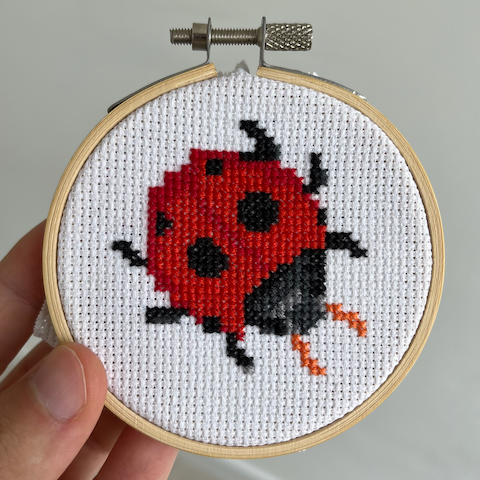
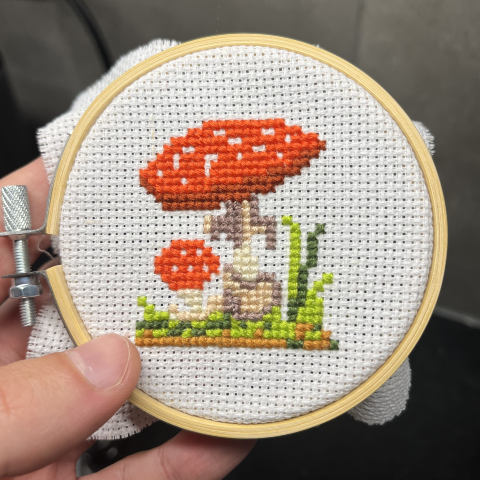
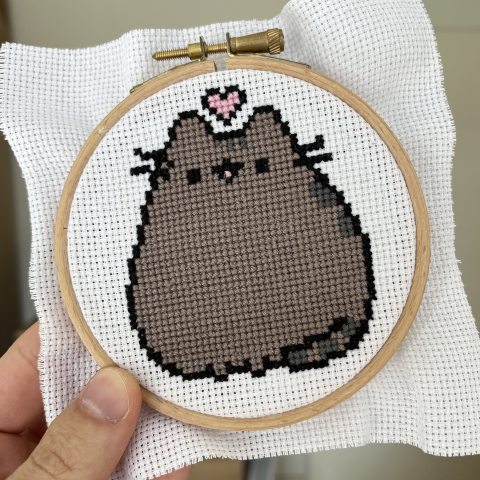
From left to right, cross-stitches of a ladybug, a mushroom, and Pusheen.
The mushroom pattern was the second cross-stitch I ever made, and the Pusheen cross-stitch I actually made for a friend and gifted it to him on his birthday.
Once I was comfortable enough with cross-stitching, I decided to go for a larger one. So far, all the cross-stitches I had made were small, and they could be completed in a few days. I thought about which pattern to go for next and decided to go for something out of the Ghibli universe. I found a pattern of Totoro, the big fluffy character from the movie My Neighbor Totoro. The pattern was not particularly complex but it was much larger than the previous ones, and it required more colours and more time to complete.
Pick the right colours
To pick the colours, you can use some online tools that convert images to cross-stitch patterns, such as Stitch Fiddle. These tools allow you to upload an image and generate a pattern with a specified number of colours and size. Personally, I just inspected visually the colours in the image and picked the closest ones from the store. Where I live, in Amsterdam, there is a store called Pipoos that sells all kinds of crafting supplies, including embroidery floss. They have a wide selection of colours and brands, so I was able to find the ones I needed for my Totoro pattern.
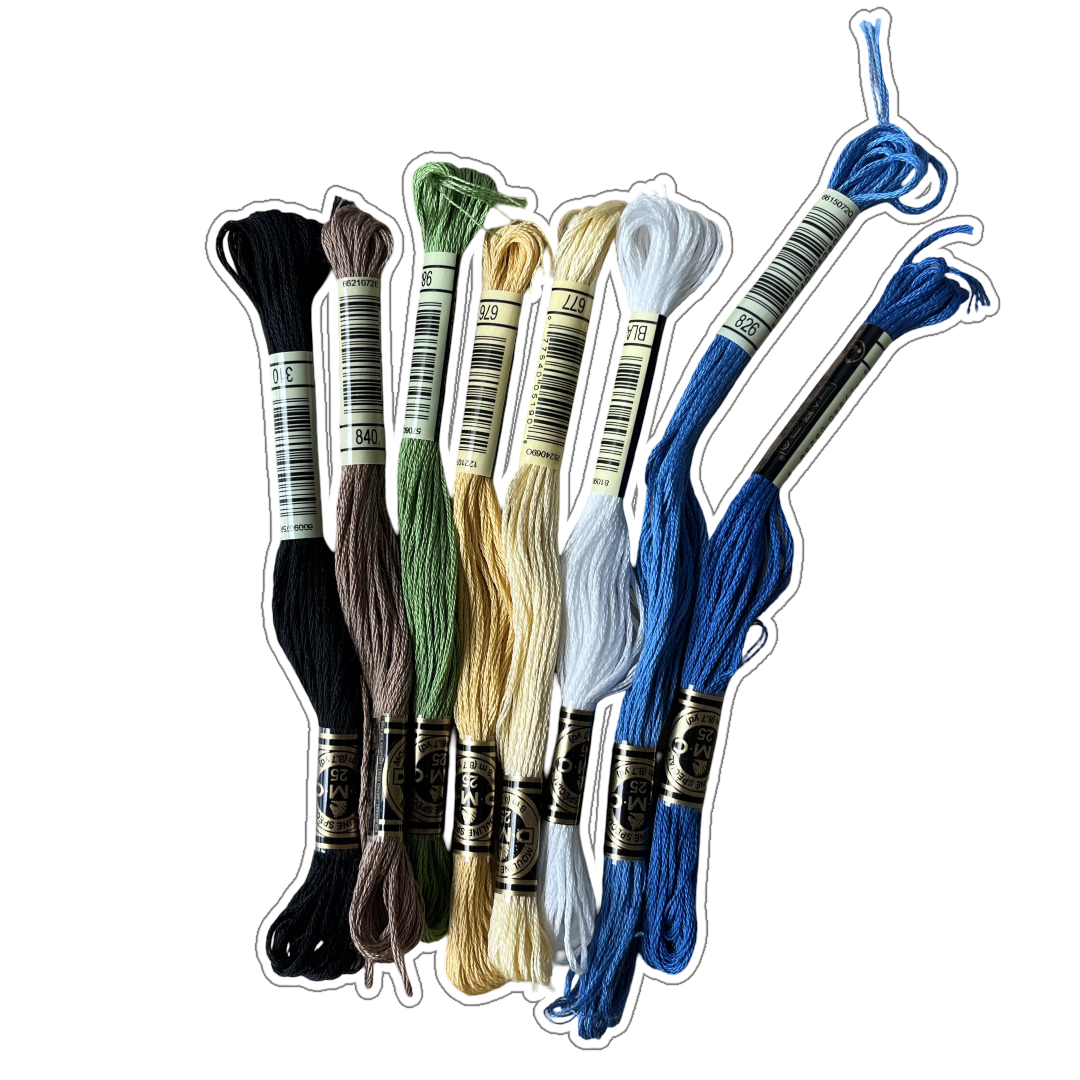
Embroidery floss used for the Totoro pattern.
🗒️ Note: There are a few standardised colour sets for embroidery floss, one of the most common being the DMC brand.
Here's a table listing all the colours and their respective DMC number used in this project:
| DMC number | Colour name | Hex code | Sample |
|---|---|---|---|
| 310 | Black | #000000 | |
| 840 | Beige Brown Vy Dk | #6B4F2A | |
| 988 | Forest Green Md | #3A6B35 | |
| 676 | Old Gold Lt | #F8E6A0 | |
| 677 | Old Gold Vy Lt | #FAF3DC | |
| BLANC | White | #FFFFFF | |
| 826 | Blue Med | #A4D3E6 | |
| 825 | Blue Dk | #567C99 |
Gather your needles
Once the colours were picked, I looked for a suitable wooden embroidery hoop to hold the fabric taut while stitching. The hoop also prevents the cloth from wrinkling. The pattern itself, I replicated it from a Reddit post, replacing the pink umbrella with blue. The cross-stitching technique itself is quite simple, and there are many tutorials available online. The key is to keep the stitches consistent in size and direction, and to follow the pattern carefully. In a nutshell, you make an "X" shape with the thread, going from one corner of the square to the opposite corner, and then back again. You repeat this process for each square in the pattern. If you make a mistake, you can easily undo the stitches and redo them (depending on how far back you need to go). Personally, I just followed a few YouTube tutorials to get the hang of it.
Stitch it all together
Once all the materials have been gathered, it's time to start stitching. This is a slow and methodical process. For me, it was a very soothing and meditative activity. It really helped me stay grounded and focused, having my mind busy with this one task, and putting the rest of the noise to sleep. It was also a great way to take a break from screens and technology, which I indulge in very often, both professionally and personally.
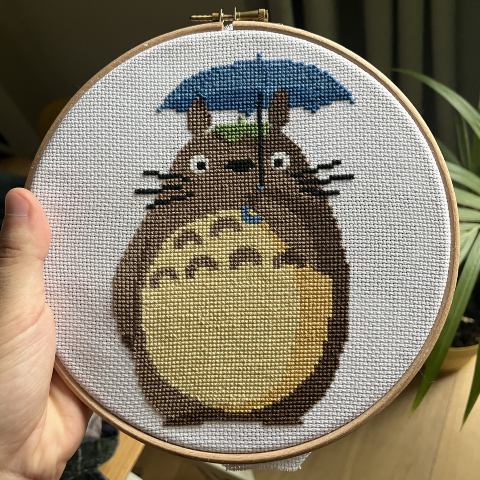
Cross-stitch of the beloved Ghibli character, Totoro.
Outro
I can definitely recommend cross-stitching for anyone curious enough to try it. It's a great way to put your mind at rest, whilst still keeping your hands busy. You don't need any special skills or experience to get started. Just a bit of patience at first, and a willingness to learn the basics. Once you get the hang of it, you'll see it's a rewarding and satisfying hobby.